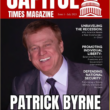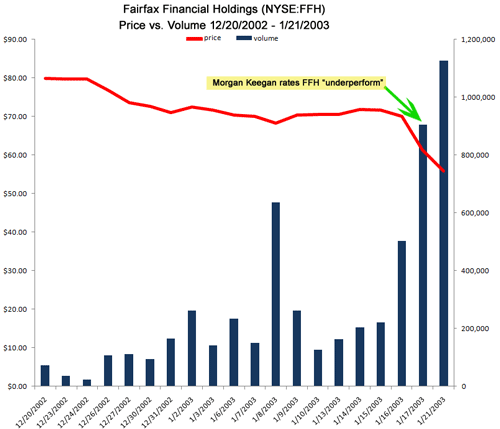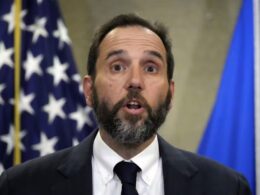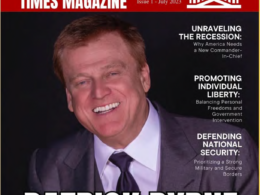Fairfax Financial Holdings (NYSE:FFH) was first listed on the NYSE on December 20, 2002. During its first 15 trading days there, volume averaged well under 180,000 shares.
Then, on January 16, 2003 FFH volume exceeded 500,000 shares on an otherwise uneventful day in the life of a Canadian insurance company.
The next day, January 17, 2003 Morgan Keegan analyst John Gwynn initiated coverage of FFH with a scathing report and rating of “underperform”, making for one of the more eventful days in the lives of Fairfax shareholders, as their investments took heavy losses on extremely high volume.
Because information drives markets, one would expect to see extra activity in the wake of new information, such as that introduced by Gwynn on the 17th.
But what accounts for the unusually high volume observed the day before Gwynn’s report was published?
The answer to that question would come in October of 2008, when Morgan Keegan announced that Gwynn had been terminated for sharing his unpublished research on Fairfax with a small group of short-selling hedge funds.
Thanks to email messages and trading data recently obtained through discovery in the Fairfax Financial vs. SAC Capital, et al, lawsuit, we know that hedge funds Kynikos Associates, Third Point Capital, and SAC Capital all traded ahead of this material, non-public information. According to legal briefs filed by Fairfax Financial, Rocker Partners (later Copper River Partners) did as well (Rocker Partners denies this, while fighting manfully to prevent disclosing the trading records that would establish the truth, one way or the other).
Trading on material, non-public information, dear readers, is illegal.
In attempting to unravel how all this came about, one hedge fund name appears over and over: Kynikos Associates, run by James Chanos, who also serves as Chairman of the Coalition of Private Investment Companies, the hedge fund industry’s Washington DC lobbying organ.
It started on December 11, 2002 when Kynikos employee Mark Heiman alerted Chanos that he had just learned from an analyst at Ziff Brothers Investments that a Morgan Keegan analyst was about to publish a negative report on Fairfax.
From: Mark Heiman
Sent: December 11, 2002 11:06 PM
To: James Chanos; Douglas Millett
Subject: Fairfax
I just got off the phone with ZBI’s insurance analyst, Michael Ting. He just talked to a new insurance analyst at Morgan Keegan, and apparently that analyst is about to initiate FFRX at “Underperform,” with the thesis being that they are extremely under-reserved into the $3-$5 BN area. Also, there may be an article in Forbes or Fortune soon that will be similarly critical.
Ting said he thought that analyst was one of the best P&C analysts he has talked to, and wanted to give us the heads-up, as well as hear how we’re coming at it.
The next day, Kynikos employee Matt Cantrell apparently contacted Gwynn, as he sent Ting several documents relating to Fairfax subsidiaries, with the comment, “John Gwynn believes these might be of interest to you.”
Four days later, Heiman spoke to Gwynn personally, having a conversation which he summarized in the following report to Chanos:
From: Mark Heiman
Sent: December 16, 2002 4:46 PM
To: James Chanos; Douglas Millett; Charles Hobbs
Subject: Fairfax
Just spoke to John Gwinn at Morgan Keegan, and he was more critical of FFRX than I’ve ever heard a sell side analyst. It looks like his criticisms of from the top to the bottom–everything from underwriting to accounting to dishonesty. He gave me his basics, as he is somewhat restricted because he hasn’t officially launched. It will be interesting to see how much of this the people who run the research department there will let him publish!
On December 18, 2002, Chanos forwarded Heiman’s email to Jeff Perry, then an analyst at SAC Capital.
The day after Fairfax began trading on the NYSE, Gwynn’s revelations became much more explicit as he shared with Kynikos employee Heiman portions of his forthcoming report on Fairfax.
From: Mark Heiman
Sent: December 21, 2002 6:03 PM
To: James Chanos; Douglas Millett; Charles Hobbs
Subject: Fairfax
Last night John Gwinn at Morgan Keegan faxed over to me an outline detailing the issues at FFH, basically those he will be publishing on. He has been a huge help and even offered to talk to me from his home today. We can look at these and talk to him next week–I just wanted to come in today and take a look at what he sent to get a head start on what he sent.
In the days to follow, Gwynn and SAC Capital Portfolio Manager Forrest Fontana held a face to face meeting where they discussed Fairfax.
Fontana followed up on that meeting via email to Gwynn:
From: Forrest Fontana
Sent: January 06, 2003 8:57 AM
To: John Gwynn
Subject: RE: hope you had a nice holiday!
you available to touch-base on Fairfax sometime this week?
Followed by Gwynn’s prompt and eager reply:
From: John Gwynn
Sent: January 06, 2003 9:01 AM
To: Forrest Fontana
Subject: RE: hope you had a nice holiday!
Name the time.
Fontana proposed a conversation the following day and requested a spreadsheet summarizing Gwynn’s analysis on Fairfax, which Gwynn promised to send.
On January 13, 2003 Fontana sent his boss, Steven A. Cohen himself, a summary of his planned activities for the week, which included:
Tuesday 1/14: Morgan Keegan expected to launch on Fairfax with sell rating – we will be covering into this.
As it turns out, Gwynn’s report was published on the 17th of January, not the 14th as Fontana expected. Still, it’s clear that SAC Capital was formally planning to trade ahead of the information received by Gwynn.
Trading records produced by Kynikos and Third Point all tell the same story: heavy short selling in anticipation of Gwynn’s report, and highly profitable short covering in the days that followed.
What did John Gwynn get out of all this? That’s unclear, though upon his firing, Morgan Keegan went to great lengths to say that Gwynn’s opinions were his own and not influenced by the hedge funds that profited from advance knowledge of them.
The next question is: did Morgan Keegan get anything out of this arrangement?
The answer is yes: On December 21, 2002, the day after Kynikos received Gwynn’s unpublished analysis, Kynikos money manager Douglas Millett declared his intention to begin sending business to Morgan Keegan.
Apparently, that’s how big hedge funds like Kynikos operate, which makes Kynikos President James Chanos the logical person to represent his peers before Congress as that body considers long-overdue reforms.
Addendum: today (January 9, 2009) I received a letter from the attorney of Rocker/Copper River Partners protesting my suggestion that the firm was among those trading ahead of the Morgan Keegan report on Fairfax referenced above. In short, Rocker says the analysis was released on January 16, 2003 and their short position established the following day. The story has been slightly edited to reflect their position. I am currently examining the specifics of Rocker’s objections — though find that difficult given Rocker’s attorneys have taken steps to keep sealed what they insist is exculpatory evidence — and will return to this issue shortly.
If this article concerns you, and you wish to help, then:
1) email it to a dozen friends;
2) go here for additional suggestions: “So You Say You Want a Revolution?“








